
Wetenschap
Kleine tornado verbetert de prestaties van elektrospray-ionisatiemassaspectrometrie
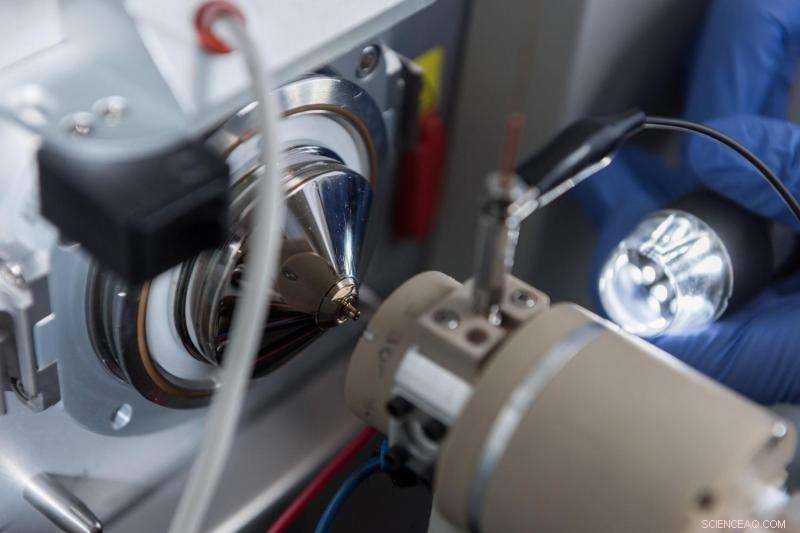
Het DRILL-apparaat is verbonden met een massaspectrometer om geladen druppeltjes te sorteren en de desolvatie van geïoniseerde biomoleculen voor analyse te verbeteren. Het apparaat vereist geen wijziging van de massaspectrometer, en kan worden ondergebracht in de standaard workflow die nu door onderzoekers wordt gebruikt. Krediet:Rob Vilt, Georgië Tech
Door het equivalent van een miniatuurtornado toe te voegen aan de interface tussen elektrospray-ionisatie (ESI) en een massaspectrometer (MS) hebben onderzoekers de gevoeligheid en het detectievermogen van de veelgebruikte ESI-MS-analysetechniek kunnen verbeteren. Een van de wetenschappelijke gebieden die baat kunnen hebben bij de nieuwe techniek zijn proteomics, metabolomics en lipidomics – die dienen voor biomedische en gezondheidstoepassingen, variërend van detectie en diagnostiek van biomarkers tot het ontdekken van geneesmiddelen en moleculaire geneeskunde.
Bekend als droge ionenlokalisatie en voortbeweging (BOOR), het nieuwe apparaat creëert een wervelende stroom die elektrospraydruppels kan scheiden, afhankelijk van hun grootte. In deze toepassing, een van de vele mogelijke toepassingen voor DRILL, de kleinere druppeltjes worden gericht om de massaspectrometer binnen te gaan, terwijl de grotere - die nog steeds oplosmiddel bevatten - in de vortexstroom blijven totdat het oplosmiddel verdampt. Het verwijderen van het oplosmiddel maakt analyse mogelijk van extra ionen die bij de huidige technieken verloren kunnen gaan en vermindert de chemische "ruis" die de selectiviteit van de massaspectrometer remt.
"Een grote uitdaging voor het detecteren van kleine hoeveelheden biomoleculen met behulp van massaspectrometrietechnologie is dat we niet alles kunnen zien wat zich daadwerkelijk in het monster bevindt, " zei Matthew Torres, een assistent-professor aan de Georgia Tech's School of Biological Sciences. "Het DRILL-apparaat biedt een nieuwe manier om dat probleem op te lossen door het aantal ionen dat we in het massaspecificatie-instrument kunnen krijgen te vergroten, zodat we ze productief kunnen detecteren. De ionen zijn er nu, maar niet noodzakelijk in een vorm die de massaspecificatie aankan."
Ontwikkeld door onderzoekers van het Georgia Institute of Technology met steun van de North Carolina State University, DRILL kan worden toegevoegd aan bestaande elektrospray-ionisatiemassaspectrometers zonder deze te wijzigen.
"Het principe is om de druppels te laten roteren en traagheid te gebruiken om ze op grootte te scheiden, " legde Andrei Fedorov uit, een professor aan de Woodruff School of Mechanical Engineering van Georgia Tech. "We willen dat de druppeltjes lang genoeg in de stroom blijven om het oplosmiddel te verwijderen. In de praktijk kleinere druppeltjes blijven in het midden, waar ze zijn, kunnen eerst worden verwijderd voor analyse, terwijl de grotere aan de rand van de stroom blijven totdat ze zijn gedroogd."
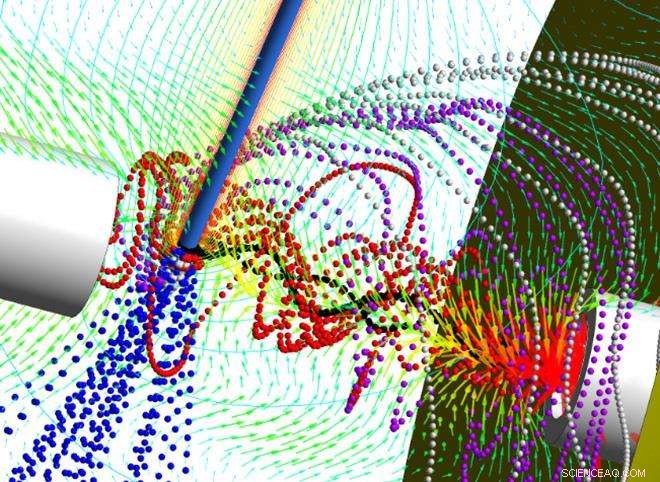
Dit schema geeft weer hoe het DRILL-apparaat werkt terwijl het ionen naar de massaspectrometer verzendt met behulp van een zorgvuldig ontworpen vortexstroom. Krediet:Peter Kottke, Georgië Tech
Het kernidee van DRILL is gebaseerd op Fedorov's uitvinding uit 2007 "Confining/Focusing Vortex Flow Transmission Structure, Massaspectrometriesystemen, en methoden voor het verzenden van deeltjes, Druppels, en ionen." (Amerikaans octrooi nr. 7, 595, 487). In de afgelopen drie jaar, het DRILL-apparaat is ontwikkeld met steun van het National Institute of General Medical Sciences van de National Institutes of Health, en de nieuwste versie werd op 14 juni beschreven in het tijdschrift American Chemical Society Analytische scheikunde .
Bij elektrospray-ionisatie (ESI), een elektrische potentiaal wordt toegepast op een oplossing in een capillair, produceren van een sterk elektrisch veld aan de capillaire spuittip. Dat leidt tot de verdrijving van een aerosol met daarin geladen druppeltjes die de te analyseren moleculen dragen. The ejected droplets then break up into smaller droplets, creating a plume that expands spatially beyond the inlet intake capacity of the mass spectrometer, resulting in sample loss. The DRILL device provides an effective interface for collection and transmission of charged analytes from ionization sources, such as ESI, to detection devices, such as mass spectrometers, resulting in significantly improved detection capability.
As much as 80 to 90 percent of large biopolymers (proteins, peptides, and DNA) are currently lost to analysis using existing ESI-MS techniques, which have grown in importance to the life sciences community. Capturing all of the biopolymers could lead to new discoveries, said Torres, whose lab studies post-translational changes in proteins. By allowing analysis of large biomolecules, DRILL could facilitate top-down proteomics in which complete protein molecules could be studied without the need to enzymatically break them up into smaller pieces before MS analysis.
"This could allow us to see combinatorial modifications that exist on a single protein molecule, " said Torres. "It's very important for us to understand how proteins communicate with one another, and DRILL may allow us to do that by more effectively removing the solvent from these types of samples."
The Georgia Tech researchers are using DRILL in their lab to interface between liquid chromatography and the ESI-MS instrument. Multiple electrodes and inlet/outlet ports enable precise control over the flow generation and guiding electric field inside the DRILL, so the device can be configured for a variety of uses, Fedorov noted. In a general sense, DRILL adds a new approach for manipulating the trajectory of charged droplets, die, when combined with hydrodynamic drag forces and electric field forces, provides a rich range of possible operational modes.
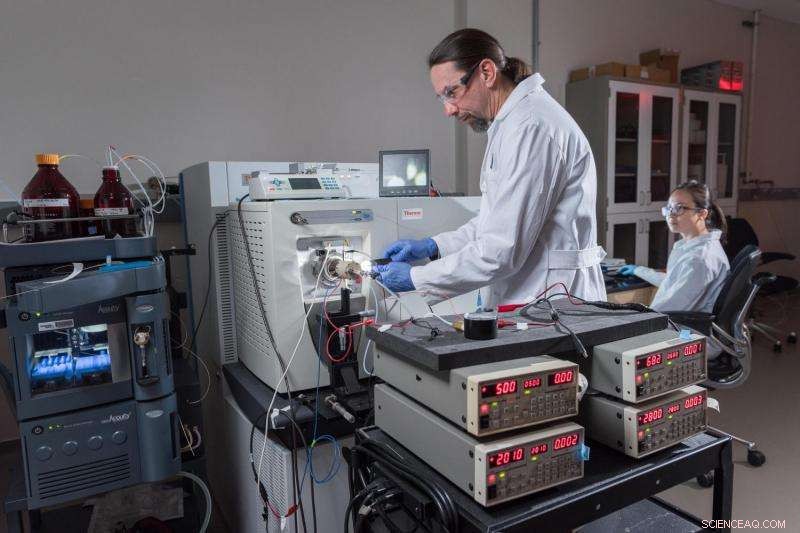
Research Scientist Alex Jonke (left) connects DRILL to a mass spectrometer in the Torres laboratory at Georgia Tech, while Graduate Research Assistant Jung Lee prepares to collect mass spectra resulting from the analysis. Krediet:Rob Vilt, Georgië Tech
DRILL can improve the signal-to-noise ratio by a factor of 10 in the detection of angiotensin I, a peptide hormone, and boost the sensitivity for angiotensin II ten-fold to picomole levels. DRILL demonstrated improved signal strength – up to 700-fold – for eight of nine peptides included in a test extract of biological tissue.
DRILL could potentially allow the study of entire cell contents, analyzing thousands of different molecule types simultaneously. That could allow researchers to see how these molecules change over time to detect problems in chemical pathways and to determine why drugs work in some people and not others.
"This could be a huge advance for biologists and others who are interested in protein biochemistry and cell biology because it enhances the sensitivity of the analytical technical and overcomes a major hurdle in studying large biological molecules, " Torres added. "We expect to be able to see things we haven't been able to see before."
The Georgia Tech researchers have been collaborating with David Muddiman, a professor in the Department of Chemistry at North Carolina State University, on developing DRILL and its analytical characterization using state-of-the-art mass spectrometry experiments. A unique contribution of the North Carolina State University researchers is in using a powerful statistical method called "design of experiments" to guide the multi-parameter optimization of the DRILL device, resulting in identification of a sweet spot for optimal operation.
Fedorov and Torres hope to expand use of the DRILL device beyond Georgia Tech laboratories and further enhance its design. Among the near-term improvements planned is the addition of internal heating to accelerate the removal of solvent. "We see many additional improvements that will allow DRILL to further enhance the ESI-MS process, " said Fedorov. "We plan to continue evolving it as more labs start to use the device."
 Aanpak maakt weg vrij voor nieuwe generatie antimicrobiële materialen
Aanpak maakt weg vrij voor nieuwe generatie antimicrobiële materialen Succesvolle synthese van nanomateriaal dat de efficiëntie van de katalysator verbetert
Succesvolle synthese van nanomateriaal dat de efficiëntie van de katalysator verbetert Hoe maak je kleurrijke rookbommen
Hoe maak je kleurrijke rookbommen  Onderzoekers vinden potentieel in milieuvriendelijke synthesizer
Onderzoekers vinden potentieel in milieuvriendelijke synthesizer Bloemachtige nanostructuren in natriumbatterijen
Bloemachtige nanostructuren in natriumbatterijen
 Het verhogen van het grondwaterpeil in landbouwveengebieden kan de sleutel zijn tot het verminderen van de uitstoot van broeikasgassen in het VK
Het verhogen van het grondwaterpeil in landbouwveengebieden kan de sleutel zijn tot het verminderen van de uitstoot van broeikasgassen in het VK Door de mens veroorzaakte aerosolen geïdentificeerd als drijvende kracht achter veranderende wereldwijde regenvalpatronen
Door de mens veroorzaakte aerosolen geïdentificeerd als drijvende kracht achter veranderende wereldwijde regenvalpatronen Dodelijke storm teistert Spanje sluit scholen, onderbreekt de stroom
Dodelijke storm teistert Spanje sluit scholen, onderbreekt de stroom Hoe beïnvloeden bergen precipitatie?
Hoe beïnvloeden bergen precipitatie?  Schattingen van de vermindering van de CO2-uitstoot van ecosystemen verbeterden in de richting van het doel van de overeenkomst van Parijs
Schattingen van de vermindering van de CO2-uitstoot van ecosystemen verbeterden in de richting van het doel van de overeenkomst van Parijs
Hoofdlijnen
- Een vogel in de bush is $223 waard, 851 in de hand
- Verschil tussen recombinant DNA en genetische manipulatie
- Lood visgerei kan een bedreiging vormen voor de populaties van duikers
- Kenmerken van ATP
- Een flitsende gele keelzanger? Daar zijn genen voor
- De structuur en functie van een cel
- Hoe het plasmamembraan regelt wat er in komt en uit een cel komt
- Verschillende populaties bosolifanten bijna instorten in Centraal-Afrika
- Wat is het verschil tussen Ribosoom en Ribosomaal DNA?
- Nieuwe methode kan scheuren in metaal opsporen lang voordat ze catastrofes veroorzaken
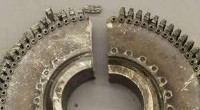
- Kwantumchemie lost het mysterie van de 20 aminozuren in de genetische code op

- Gemodificeerde biomaterialen zelf-assembleren op temperatuursignalen

- Onderzoekers ontwikkelen molecuul om zonne-energie op te slaan

- Onderzoekers ontdekken een manier om in eiwitten te kijken om te zien hoe ze zijn bedraad
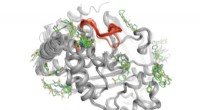
 Ongeordende kristallen zijn veelbelovend voor toekomstige batterijtechnologie
Ongeordende kristallen zijn veelbelovend voor toekomstige batterijtechnologie Hoe een percentagevergunning tussen twee getallen berekenen
Hoe een percentagevergunning tussen twee getallen berekenen Volgende stop:Een reis in de atmosfeer van de Suns
Volgende stop:Een reis in de atmosfeer van de Suns Uber schakelt achteruit bij teleurstellend Wall Street-debuut
Uber schakelt achteruit bij teleurstellend Wall Street-debuut Het evenwicht herstellen in datasets voor machine learning
Het evenwicht herstellen in datasets voor machine learning Studie geeft nieuw inzicht in de oorsprong van de caldera van de Canarische Eilanden
Studie geeft nieuw inzicht in de oorsprong van de caldera van de Canarische Eilanden Onderzoekers ontdekken nieuwe mogelijkheden voor het oogsten van licht
Onderzoekers ontdekken nieuwe mogelijkheden voor het oogsten van licht Worstelende gezinnen zeggen dat een gebrek aan voedsel het thuisleren bemoeilijkt
Worstelende gezinnen zeggen dat een gebrek aan voedsel het thuisleren bemoeilijkt
- Elektronica
- Biologie
- Zonsverduistering
- Wiskunde
- French | Italian | Spanish | Portuguese | Swedish | German | Dutch | Danish | Norway |

-
Wetenschap © https://nl.scienceaq.com

